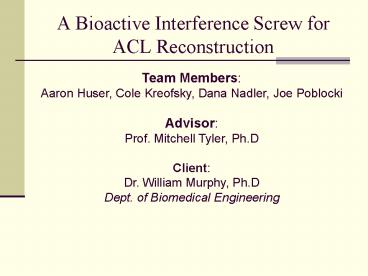A Bioactive Interference Screw for ACL Reconstruction - PowerPoint PPT Presentation
1 / 17
Title:
A Bioactive Interference Screw for ACL Reconstruction
Description:
A thermoplastic is poured into the. mold and allowed to cool. Upon setting, the screw is removed ... Crosslinker poured onto membrane. Induces gel state. Re ... – PowerPoint PPT presentation
Number of Views:301
Avg rating:4.5/5.0
Title: A Bioactive Interference Screw for ACL Reconstruction
1
A Bioactive Interference Screw for ACL
Reconstruction
Team Members Aaron Huser, Cole Kreofsky, Dana
Nadler, Joe Poblocki Advisor Prof. Mitchell
Tyler, Ph.D Client Dr. William Murphy,
Ph.D Dept. of Biomedical Engineering
2
(No Transcript)
3
Problem Statement
- The purpose of this project is to design an
interference screw for ACL reconstruction that
will promote and foster the growth of tissue and
secure the graft.
4
Problem Motivation
- Currently, the majority of interference screws
are made of titanium or partially bio-degradable
material. These materials may inhibit tissue
growth or cause unwanted debris in the patellar
region of the body. - A minority of interference screws are composed of
a mixture of bioactive materials and polymers.
These screws only promote tissue growth of small
magnitudes.
5
Design Constraints
- The screw must be
- bioactive
- biocompatible
- easily sterilized or autoclaved
- biodegradable as tissue re-grows
- able to withstand the stresses involved in
surgery and limited postoperative activity
6
Background ACL Reconstruction
- 90,000 annual ACL reconstruction surgeries
worldwide - Reconstructions use patellar or hamstring tendon
grafts - Grafts are implanted in the femur and tibia
- Grafts are secured with interference screws
http//www.orthoohio.com/OIO_services_surgeries.ht
ml
- http//miranda.ingentaselect.com/vl2967323/cl12/
nw1/fmdocpdf/rpsv/cw/pep/09544119/v217n1/s9/p59
7
Background Current Screws
- Most interference screws are titanium
- Bioactive interference screws are starting to be
utilized - Current bioactive screws degrade incompletely and
asynchronously with tissue formation - Both types have varying geometries and sizes
- Multiple companies produce these types of screws
http//www.arthrotek.com/products/aclpcl_interfere
nce.cfm
http//www.jnjgateway.com/home.jhtml?locUSENGpag
eviewContentcontentId09008b9880a6f43eparentId
09008b9880a6f43e
8
Background Hydrogel Templates
- Water-based scaffolds used to mimic extracellular
fluid - Promote cell proliferation and tissue growth
- Can be differentiated with growth factors,
nutrients, metabolites, etc. - A mineralization process calcifies the hydrogel
to meet mechanical demands - Ultimate degradation replaces hydrogel with
tissue
http//www.sciencedirect.com/cache/MiamiImageURL/B
6TWB-4D4PS12-2-1/0?wchpdGLbVzz-zSkzk
9
Hollow Screw Shaft
- Why?
- Maximize torque
- Minimize possible surgical damage
- Provides increased surface area for tissue growth
http//www.stryker.co.uk/ms_pic_interference-wedge
-screw-2.jpg
10
Producing The Hollow Screw Shaft
- A modular screwdriver is place inside mold
- The screwdriver is coated with a non-
sticking agent - A thermoplastic is poured into the mold and
allowed to cool - Upon setting, the screw is removed from the
mold
http//www.sulzerorthoeu.ch/images/product/sm-11.g
if
http//www.aclstudygroup.com/Powerpoint-pdf02/bios
crews-hamstrings-johnson.pdf
11
Technique Alternative 1Diffusive Membrane
Application
- Mold is split into two halves
- Shaft-fitting semi-permeable membrane
- Hydrogel monomer injected into threads
12
Technique Alternative 1Diffusive Membrane
Application
- Crosslinker poured onto membrane
- Induces gel state
- Re-attach mold halves
- Mineralization hardens gel (i.e. Ca2)
- Remove membrane after setting
- Apply thermoplastic
- Hollow shaft
13
Technique Alternative 2 Static UV Application
- Tube inserted into mold
- UV-activated crosslinker/hydrogel mixture
- UV light activates crosslinker
- Tube removed, mineralization occurs
- Thermoplastic application is carried out
- Mold is unhinged and screw is removed
14
Technique Alternative 3Rotational Application
- Hydrogel and UV-activated crosslinker
- The mold is rotated allowing solution to fill
threads - UV light polymerizes hydrogel
- Mineralization and thermoplastic application
15
Technique Matrix
Scale of 1 10 10 being the best 1 being the
worst
16
Future Work
- Research methods for fabricating molds
- Continue researching the hydrogel process
- Develop a prototype mold
- Test various facets of molded interference screws
- Biocompatibility
- Degradation
- Structural Integrity
- Ease of development
17
?QUESTIONS?































